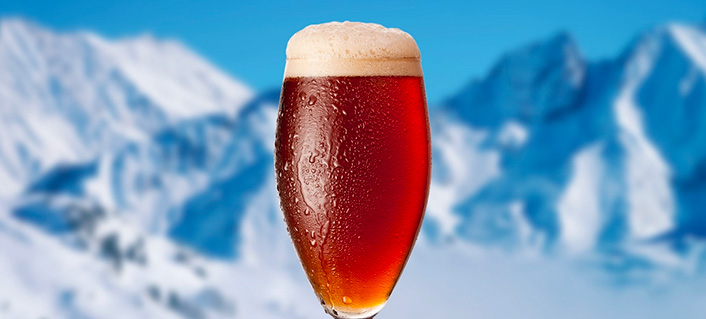Doppelbock, the perfect winter beer?

The days are getting shorter, the air a little cooler and the trees have nearly shed all their leaves. Yes, it would seem despite our best efforts, winter is coming. And what better way to blunt the frozen fist of Jack Frost than with a pint of beer? But not just any beer will do. No, it must be strong, bold, dark with just the right amount of sweetness. But does such a beer exist? Is there a perfect winter beer? We submit for your consideration, the doppelbock.
Intense flavors of caramel malt and a soft roast finish are paired with a delightfully dark color and a rich body, wrapped in a solidly high 7-10% abv. It warms you, fills you up and goes perfectly with rich roasted foods or desserts. If that doesn’t sound like the perfect beer for the winter holidays, we don’t know what does.
Now let’s dive a little deeper into this delightful beer’s origins.
Why Doppel?
Doppel in German means double. To put it simply a Doppelbock is double the ‘bock;’ or even simpler it’s a stronger version of a German-style bock beer. Similar to other uses of the word “double” in beer, like a Double IPA, you can expect higher ABV and more intense flavor. And when it comes to bocks, Doppel is just the beginning. There’s the original bock or Dunkel Bock. There’s the Maibock, a more hop-centric paler bock. A Weizenbock that’s brewed with wheat. There’s even an Eisbock or “ice bock” a stronger bock made by freezing the beer and removing the excess ice leaving more of the alcohol behind.
Doppelbock Begins
The Doppelbock’s origins can be traced all the way to back to 1600s where it was first brewed by monks at the Paulaner brewery in Munich. But the history here is as dark and opaque as the beer itself. The most popular legend is that the monks created the beer as a means of sustenance during their Lenten fast. Others argue the beer was never used for fasting, but instead the opposite, saying it was meant for celebration and feasting.
It seems the truth is likely somewhere in the middle. In 1651 the monks at Paulaner celebrated the Feast Day of their founding father, Saint Francis of Paola, where they drank and served Sankt-Vaters-Bier (Beer of the Sacred Father) to the townsfolk. Since this annual event was held in April it sometimes took place during Lent. So, it was both drank as a part of a feast, but also during Lent…hence the confusion.
The Sankt-Vaters-Bier would eventually become known as Salvatorbier or Salvator, which means savior in Latin. Centuries later Paulaner would trademark the name “Salvator”, even today breweries continue to honor the original by ending their doppelbock names with “-ator”.
Although the history is murky, what is clear is Doppelbocks are a delicious hearty beer and can be drank on any occasion. We just don’t recommend using it as a meal supplement.
Sources:
The Real Story of Doppelbock, Mark Dredge
Style School: The Hallowed Comforts of Doppelbock, Jeff Alworth
Brew it yourself with recipes from Weyermann®:
WEYERMANN® Nr. 9 Willy Wonka Bock
WEYERMANN® Bamberger Hofbräu® Exquisator
Classic & Contemporary Examples:
Ayinger Celebrator, Ayinger Privatbrauerei (Aying, Germany)
Dominator Doppelbock, Black Hoof Brewing Co. (VA) (Bronze, German-Style Doppelbock or Eisbock, 2022 World Beer Cup)
Dissimulator, Twin City Brewing Company (BC) (Silver, Bock – Traditional German Style, 2022 Canadian Brewing Awards)
Elevator Doppelbock, Hell’s Basement Brewery Inc. (AB) (Gold, Bock – Traditional German Style, 2022 Canadian Brewing Awards)
Emancipator, Spilled Grain Brewhouse (MN)
Frogichlaus Swiss-Style Celebration Lager, Hoppin’ Frog Brewing (OH) (Silver, German-Style Doppelbock or Eisbock, 2022 World Beer Cup)
Navigateur, Brasseux d’la Cote (NB) (Gold, Canada Beer Cup)
The Regulator, Rahr and Sons Brewing Company (TX)
Road Block Doppelbock, Walkerville Brewery (ON)
Salvator, Paulaner Brauerei (Munich, Germany)
Samuel Adams Double Bock, Boston Beer Co.(MA)
Spectator, On Tour Brewing Company (IL)
Ingredients Breweth the Beer
Malt
There are arguably many ways to brew a Doppelbock. But when it comes to malt, we recommend combining a German or Munich style with a roasted malt to produce the Doppelbock’s classic malty, bready, toasted characteristics and dark amber color.
Gambrinus Organic Munich Light
Weyermann® CARAFA® Special Type 1 (dehusked)
Watch: Inside Weyermann® – Carafa® & more: The roasted malts of Weyermann®
Hops
Doppelbocks traditionally have a low bitterness and very little hop aroma and flavor. So going with a German noble hop is a safe bet.
The quintessential noble hop, mild and approachable with a mixture of sweet, earthy and herbal notes.
Versatile and mild, predominantly spicy with an undercurrent of woods and wild fruit.
American-bred descendent of Hallertau Mittelfrüh, it is moderately intense and sweet with suggestions of herbal notes, flowers and green fruit
Yeast:
Originating from the famous VLB institute in Germany, Fermentis SafLager™ S-23 is a true lager yeast capable of producing continental lagers with fruity notes, perfect for a Doppelbock.